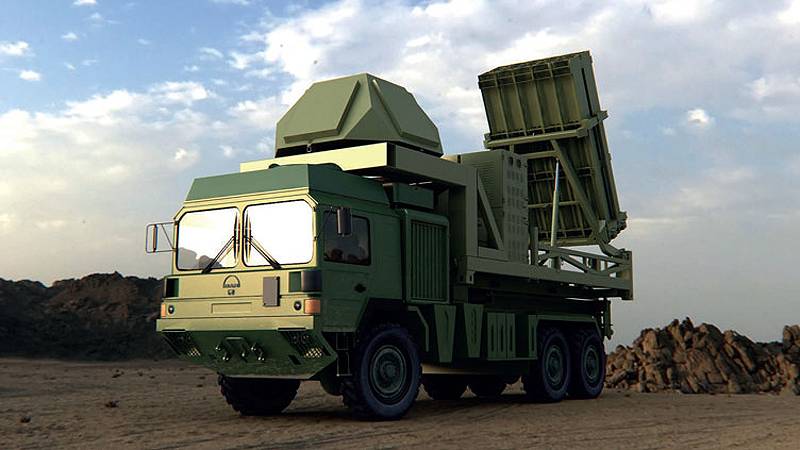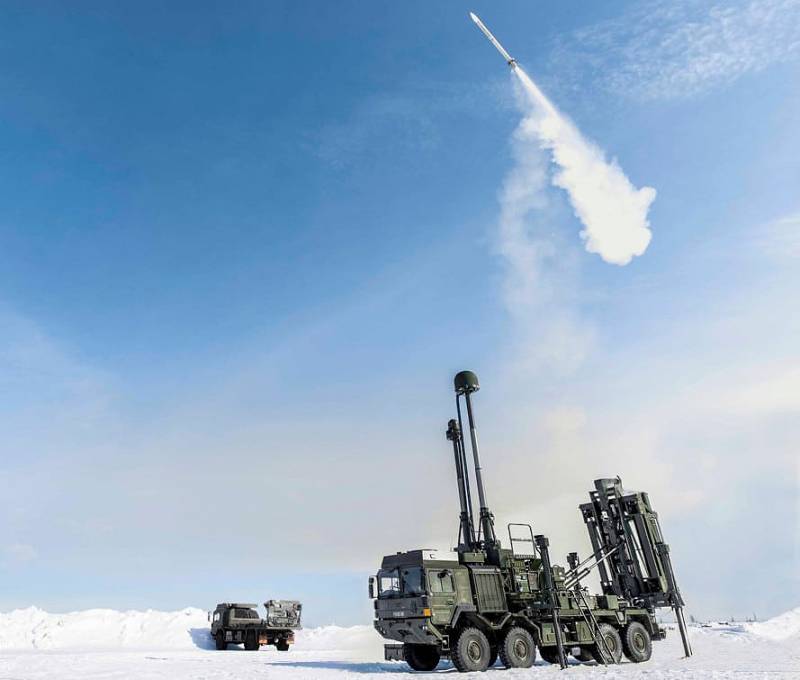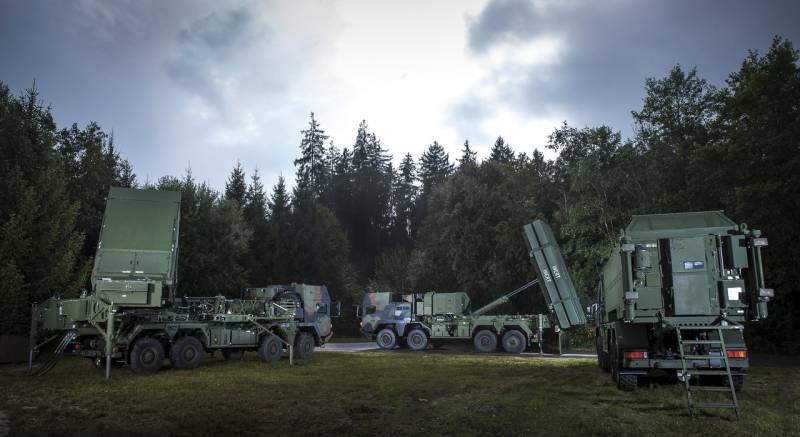Complicated solutions: enhancing the role of ground defense
In 2018, a Land Ceptor rocket was tested in Sweden.
Due to the fact that the fighters of the fifth and sixth generations, unmanned aerial vehicles, high-tech missiles and ballistic systems are coming into service with an increasing number of countries, ground forces must meet the new requirements that these aerial threats impose and use appropriate defensive capabilities.
Looking at the wide choice of programs on ground-based air defense systems implemented in many countries, one can notice certain changes that underlie such decisions.
- said Justin Bronk, a senior fellow at the British Institute for Defense and Security Studies.
However, the procurement of air defense systems and equipment is not as simple as it seems, and the purchase of advanced high-class complexes may have wider implications.
Games "Patriots"
One of the most popular systems on the market is the Raytheon Patriot anti-missile system, which has been bought by quite a few countries. However, this solution is not available to everyone, mainly due to the high cost, and the need for short-range systems also opens up opportunities for other players in the fight for ground defense programs.
In 2018, Raytheon achieved great success with its Patriot complex. Contracts with Poland and Romania were confirmed, which are carried out as part of the state program for the sale of military equipment and military assistance to foreign countries. In addition, in August last year, Sweden signed a letter of acceptance of the proposal for the purchase of this system.
As a result, in December, the manufacturing company received a contract worth 693 million dollars from the US Army to manufacture Patriot complexes for Sweden. At about the same time that the contract was issued, a spokesman for Raytheon said that this purchase would allow for joint training of the Swedish and American armed forces and improve cooperation between the two countries.
The complex can potentially be sold to Turkey. At the end of last year, the US Department of Defense approved the possible sale to Ankara of Patriot MIM-104E anti-aircraft guided missiles (Patriot MIM-104E Guidance Enhancement Missile-TBM) to intercept aerodynamic and aeroballistic air targets and advanced PAC-3 missile Missile Segment Enhancements . In a package worth 3,5 billion dollars, Turkey requested four AN / MPQ-65 radar fire control stations, the same number of interception control stations, 10 AMG antennas, 20 autonomous launchers M903, 80 GEM-T missiles with launch containers, 60 PAC-3 missiles MSE and five power stations.
However, it is worth noting that although the Ministry of Defense approved this sale, it has not yet made a move. This discussion is not just about the procurement of an air defense system. If Turkey chooses the Patriot complex, this will signify a certain restoration of relations with Washington, which have deteriorated some time ago due to various factors, including the withdrawal (in one form or another) of American troops from Syria.
One of the problems is that Turkey has already pledged to acquire Russian C-400 Triumph long-range and medium-range anti-aircraft missile systems (NATO index SA-21 Growler). The order for these complexes was made in 2017, as a result, Ankara became the second foreign customer of C-400 after China. “This is very important for relations between the United States and Turkey in the context that if the Patriot were purchased, it would be purchased instead of the C-400 systems,” said Bronk.
Along with the political consequences that will arise in any choice, Turkey naturally should take into account the capabilities of each system. In fact, the C-400 complex offers a greater range of 400 km when sold with the 40H6 rocket compared to the Raytheon system, which is usually sold with the PAC-3 rocket with a 35 km range. In addition, the C-400 radar, an interspecific mobile radar complex for detecting aerodynamic and ballistic objects at medium and high altitudes 55Ж6М “Nebo-M”, has a detection area of the order of 400 km, while the Patriot AN / MPQ-65 radar has a detection area total 100 km.
Along with the technical characteristics, the compatibility of the weapons complex with other military systems, such as the F-35 Joint Strike Fighter, which was selected for the country's armed forces, is important. To take full advantage of his aviation, including flying fifth-generation aircraft, Turkey needs a ground-based air defense system that could communicate and transmit data to other air means. The Russian system will simply be incompatible with American fighters and many other NATO platforms.
It is noteworthy that Turkey has previously deployed Patriot complexes leased from the United States and Germany along its borders.
However, it is not yet very clear in which direction Turkey will unfold, although, judging by the words of Russian officials, an advance payment has already been made for the C-400 complexes. If she chooses the Patriot system, then she will have to abandon C-400, because the United States has put this condition. The time is inexorably going, the decision must be made, since the supply of С400 complex should begin in the summer of 2020.
The US Army is working to establish interaction between the THAAD and Patriot complexes.
Level solutions
Since Turkey is a member of NATO, it is quite obvious why the United States wants to "discard" it from Russian weapons. However, this is not the only country intending to buy C-400, since India has also shown interest in this complex.
October 5 2018 was announced that Rosoboronexport signed a contract for the supply of C-400 complexes to India. At the signing ceremony, the head of Rosoboronexport, Alexander Mikheyev, stated:
One of the reasons for this battle between the Patriot system and its Russian rival is that there are no other options on the market that could really cope with the growing threat of ballistic missiles being developed by countries such as North Korea.
Perhaps the only system comparable in characteristics can be considered a land-based mobile missile complex for high-altitude over-atmospheric interception of medium-range missiles THAAD (Terminal High-Altitude Area Defense), although Patriot and THAAD are systems with different specializations operating at different echelons. The THAAD complex is run by the US Missile Defense Agency, and Lockheed Martin acts as the lead contractor.
In the complex THAAD for the destruction of targets, mainly ballistic missiles, firing technology is used to kill due to direct kinetic effects. Mobile rapid deployment is operationally compatible with other missile defense components, including Aegis, Patriot / PAC-3, advanced command and control, detection, tracking and communications systems.
The US Army is one of three customers of the THAAD complex, along with Saudi Arabia and the United Arab Emirates; in 2017, the batteries of the THAAD complex are also located in South Korea. THAAD and Patriot will be merged into a single complex there, it is expected that this process will be completed by the end of 2020. Naturally, all these works are aimed at stopping risks from the northern neighbor.
The UAE became the first overseas customer for the THAAD complex, the contract was issued in December 2011, and two batteries were supplied in 2016.
Gradual changes
Meanwhile, Raytheon continues to negotiate with Poland over the Patriot complex, after 2018 in March, the country chose it as a universal means of anti-missile defense of positional troops at medium and high altitudes.
As part of this second phase of the Wista program, the Polish government wants to purchase additional Patriot 16 launchers that will be equipped with 8 batteries.
John Baird, representative of Raytheon in Poland, said at the MSPO 2018 exhibition held in Kielce that discussions on the 2 Phase began in April, almost immediately after signing the agreement on the 1 Phase.
Baird called additional technologies that the government is looking for for the 2 Stage, including a round-robin radar with AFAR, various sensors and radars of Polish production, as well as the integration of an inexpensive interceptor missile. As part of the 1 Phase, Raytheon will supply 200 PAC-3 missiles, and the 2 Phase provides the option to purchase SkyCeptor interceptor missile from the Israeli company Rafael.
Along with the increase in the number of Patriot complexes in its arsenal, Warsaw, in accordance with its program, Narew wants to purchase medium-range air defense systems. According to Byrd, Raytheon and its Norwegian partner Kongsberg will offer a NASAMS (National Advanced Surface-to-air Missile System) medium-range air defense system to meet these needs.
- Byrd explained.
A final decision on Wista is expected in the 2019 year, but the exact date of the contract still has to be announced.
An alternative solution to the NASAMS medium-range complex could be the Common Anti-air Modular Missile (CAMM) -ER interceptor missile, which was also presented at MSPO 2018. For Poland, MBDA will supply a launcher and control center, a radar station, optical electronic and infrared systems. The architecture of the complex is modular, so if necessary, various local development systems can be integrated.
MBDA hopes that the joint Polish-American defense and security treaty, which was signed in 2017, will help it provide its capabilities for the Narew project.
The spectrum of anti-aircraft weapons cannot be considered complete if there are no short-range solutions working in the same bundle with such systems as the Patriot.
- explained Bronk.

Rafael’s I-Dome complex is an Iron Dome version installed on one truck
Increasing strength
While Poland is only eyeing the purchase of NASAMS, the joint efforts of Raytheon and Kongsberg have already brought tangible success. In December last year, the US State Department approved the delivery of NASAMS complexes to Qatar for a total of 215 million dollars.
Doha requested this system along with AMRAAM (Advanced Medium-Range Air-to-Air Missile) missiles and related equipment and support. The contract will supply 40 AIM 120C-7 AMRAAM missiles, one AIM 120C-7 AMRAAM replacement guidance unit, one AIM-120C-7 replacement control unit, eight AMRAAM target missiles, launch canisters, secret software for the AN / MP radar station -64F1 Sentinel, cryptographic devices and encrypted communication stations and equipment for high-precision guidance.
AMRAAM is a further development of the Raytheon AIM-120 missile. The NASAMS complex will provide protection against cruise missiles, drones and aircraft and helicopter type.
Despite its views on Russia and its advanced ground-defense capabilities, India also looks forward to acquiring NASAMS II as part of an intergovernmental agreement with the United States. The NASAMS complex should replace the outdated Russian C-125М Pechora air defense systems of the 60-s more years of production.
Meanwhile, small countries, for example, Lithuania, with the aim of strengthening their military power, are not averse to acquiring such solutions.
The Lithuanian Deputy Minister of Defense said, “we bought medium-range air defense systems. We bought what we could, but of course our dream is to have Patriot complexes, but our budget is not designed for such purchases, it is impossible. ”
He noted that the threat coming from neighboring Russia is quite real, so air defense systems must be effective in order to overcome the ban on access to the Kaliningrad enclave.
Lithuania chose the purchase of NASAMS complexes in October 2016. Kongsberg will ship new systems to this country in accordance with the 128 million dollar contract, which was announced in October 2017.
It is likely that Lithuania and other countries in a similar situation will rely on NATO partners to supply modern air defense systems and equipment.
The NASAMS complex was also bought by Australia, Chile, Finland, Indonesia, the Netherlands, Norway, and Oman. Spain and the United States.
Progress in prototypes
Solutions in the field of ground defense can also include components of local development, which are part of the national systems, for example, it can be missiles, radar or vehicles.
In particular, in April, 2017, the company Raytheon Australia announced that it is the only supplier for the SRGBAD project, which provides for the delivery of short-range air defense systems. The kit will include several other subsystems created by the local industry, for example, a phased-array radar from CEA Technologies and a protected military vehicle Thales Hawkei.
At the Australian Army Day 2019, CEA Technologies showed a prototype ground radar of its fairly successful shipborne radar with an AFAR (active phased antenna array). The prototype, while bearing the CEA Tactical Radar or CEATAS designation, is specially designed for installation on the Australian Thales Hawkei truck. According to the Australian Department of Defense, this prototype represents the first step towards integration with the NASAMS complex within the SRGBAD project.
The UK continues to develop and test its Sky Saber air defense system, which includes a MBDA launcher with SAM missiles (Land Ceptor version) and a Saab Giraffe radar sighting system, as well as a control electronics kit from Rafael.
During the presentation of the complex at the beginning of 2018, a representative of MBDA said: “We see the future here today. You can’t change the soappick in the digital age. ”
The Sky Saber complex was displayed at the location of the 16 artillery regiment on the island of Torni.
At the end of 2018, the first experimental launches of Land Ceptor missiles - part of the Sky Saber complex of the British Army - were conducted at the Swedish test site Widsel on the Baltic Sea. For the first time, experienced launches of Land Ceptor as a unified system were conducted, including the Saab Giraffe radar. In the future, it is planned to finalize and test a series of Sky Saber complex, after which at the beginning of the 2020-s it should go into service.
Israel uses the Iron Dome tactical missile defense system developed by Rafael as a subsystem of the lowest level of its multi-level air defense and missile defense system, which has served the interests of the country since it was deployed on duty in 2011. The complex is well known for being used to protect Israel, successfully intercepting enemy missiles.
According to the manufacturer, the reality-tested Iron Dome complex managed to intercept more than 1700 missiles with a target hit rate in excess of 90%. Ten Iron Dome batteries are on the protection of Israel. Recall that each battery of the Iron Dome complex includes a multi-purpose radar EL / M-2084, a fire control center and three launchers with 20 Tamir interceptor missiles.
At Eurosatory 2018, Rafael introduced I-Dome, an integrated version with all systems installed on a single truck. The I-Dome complex includes ten Tamir interceptor missiles, a radar and an armament control system. This solution is designed to protect the mechanized units, serving as a complement to the object defense.
Rafael has teamed up with Raytheon of America to promote the Iron Dome complex in the United States. Raytheon is also working on a production version of the Iron Dome with a SkyHunter rocket. It could be used to protect American forces deployed in other countries, for example, to protect a peacekeeping contingent in Syria.
Multifunctional radar fire control, launcher and control station complex MEADS, the photo in the configuration for the German army
Procurement reform
Germany also seeks to get a new air defense solution as part of its program on air defense and missile defense (TLVS).
In order to obtain this contract, Lockheed Martin and MBDA Deutschland created a new joint venture that will manage the program if the MBDA application is approved by the Arms Procurement Agency for the German Armed Forces.
MBDA submitted its proposal for this program at the end of 2016. The proposal is based on its MEADS (Medium Extended Air Defense System) system, which is designed to defend groups of troops and important objects from tactical ballistic missiles with a range of up to 1000 km, cruise missiles, aircraft and unmanned aerial vehicles of the enemy.
Germany’s share in the MEADS project is 25%, Italy’s 16,6% and US 58,3%. MBDA and Lockheed have invested heavily in this project, but in 2011, due to its high cost, the American army abandoned it, choosing a modernized version of the Patriot complex from competing company Raytheon.
However, the German contract has more bright prospects. In the middle of 2018, Lockheed and MBDA received a second request for proposals for the development of TLVS. Germany still preferred to have its own MEADS complex, rather than the American Patriot.
The representative of the joint venture TLVS noted that “this second request for proposals is based on the first. It relies on the results of our negotiations and synchronizes the TLVS proposal with the new German approach to procurement reform, focusing on military capabilities, transparency and risk reduction, which guarantees the successful implementation of the contract. ”
So far this program has progressed too slowly. The development of the MEADS mobile complex began in the 2004 year, and today Germany is the only known customer of this system.
A promising mobile anti-aircraft missile system MEADS when entering service will replace the German Patriot complexes. However, recent contracts indicate that the Patriot complex still dominates Europe in the market of air defense and missile defense systems.
As modern missile and ballistic technologies spread, countries will be forced to buy more advanced defense systems that are able to provide reliable protection for ground forces and other important objects. Perhaps where there are gaps in air defense, an approach will be implemented, consisting in the distribution of air defense and missile defense forces and missile defense systems between countries, especially within NATO.
Materials used:
www.shephardmedia.com
www.defence24.com
missiledefenseadvocacy.org
www.raytheon.com
www.mbda-systems.com
www.lockheedmartin.com
www.kongsberg.com
militaryrussia.ru
rbase.new-factoria.ru
pinterest.com
www.wikipedia.org


Information